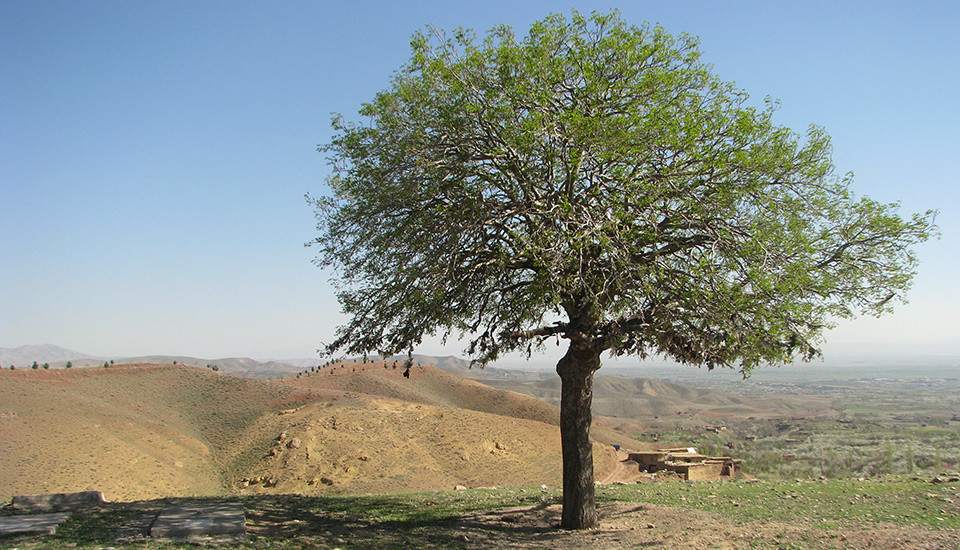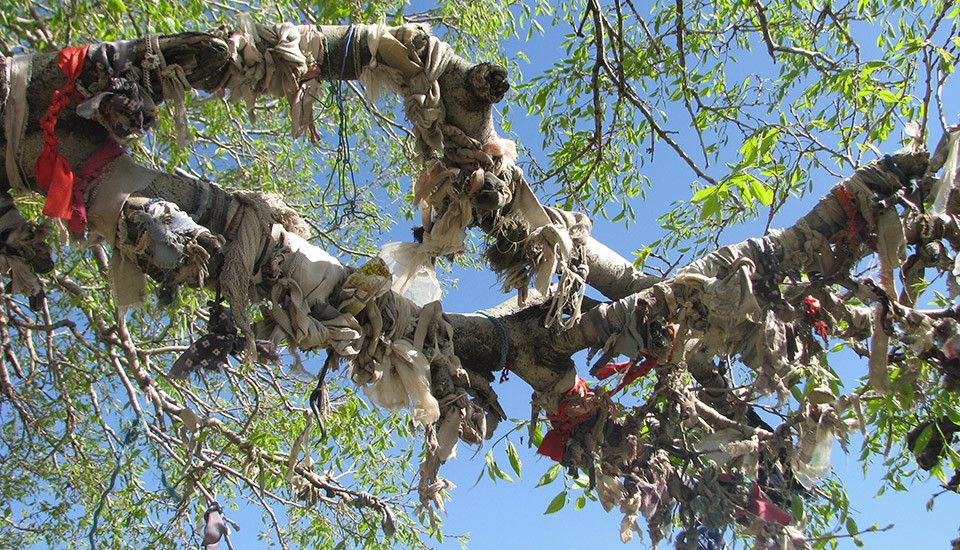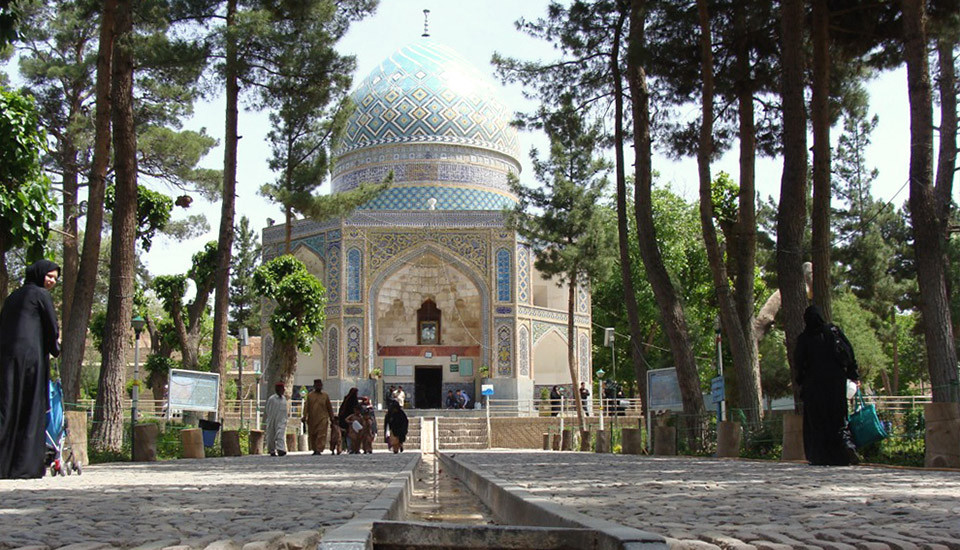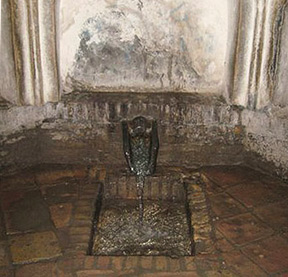Neyshabur er Township í North East Íran. Stór hluti af því er í miklum dalnum umkringdur hólum og fjöllum. Það eru mismunandi heilagt náttúruvætti í Township, allt frá heilagt tré og helgu lindir við heilaga klöpp og helga garðar. Svæðið hýsir nokkrar Einlend tegund plöntu og dýrategundum. Það inniheldur einnig verndarsvæði og áfangastaði vistkerfisins eins og fossa, lindir, ám og auga smitandi landfræðileg lögun eins leiðtogafundum fjallið. Loftslagið er hálf þurrt með að meðaltali árlega úrkomu 300 mm.
Þrátt fyrir þá staðreynd að þessar síður eru verndaðar af byggðarlögum, Framtíð þeirra er ógnað af þéttbýlismyndun, fólksfjölgun, Uppbygging innviða og ferðaþjónusta.
Protected
Vörsluaðila
Local fólk virða náttúrulega eiginleika eins og þeir eru rætur sínar í trú þeirra. Qadamgah í Neyshabur til dæmis, er Persneska garð þar sem náttúran hefur verið imbued með andlegum gildum. Það inniheldur Mansion, tré, laugar og læki. Einn af veggjum húsinu inniheldur svartan stein sem tveir sporin hafa skapað. Fólk trúir þessum prent tilheyra 8. Imam Shiites, karlmaður andlegur leiðtogi talinn vera afkomandi Muhammed, guðlega tilnefnd að leiðbeina mönnum. Orðið Qadamgah þýðir fótspor og vísar til þessa frásögn.
Saga Qadamgah sem heilagan vefur er frá for-íslamska tímabilinu. Þó að upphaflegur tilgangur þess sé óþekktur, það er sögulega tengt Sassanid prins Shahpour Kasra, sem og Imam Ali og Imam Reza. Orð fer það inn 921 Ad Imam Reza stoppaði við garðinn á leið frá Medina til Marv. Augnablikið sem hann vildi framkvæma ablús sínar, Vor vel í jörðu. Vorið hefur verið litið á heilagt síðan og fólk telur að þetta vatn hafi lækningareiginleika.
Sum plantré (Plantan sp.) hafa verið varðveittir virkan um aldir. Litið hefur verið á flugtré í Íran sem heilagt í langan tíma vegna skugga sem þeir bjóða, Mikilleiki þeirra og grænt útlit þeirra. Um allt Íran hefur verið haldið á nokkrum plantrjám í aldaraðir. Þjóðsögur og skoðanir um sum sýni hafa valdið því að fólk haldist í burtu frá þeim. Langt búið plantré í þorpi Neyshabur, til dæmis, er varðveitt af heimamönnum vegna þess að þeir telja að maður hafi einu sinni misst fjölskyldu sína vegna þess að útibú hennar brotnaði.
Heimamenn vernda enn minna þekkta heilaga staði sem hafa enga lögvernd. Gildi slíkra staður er kennt að yngri kynslóða og trúarlegum og venjur eru gerðar communally, eins og þeir hafa verið um aldir. This vegur, næsta kynslóð lærir að vernda þá.
Þótt það sé formlegt stjórnun tækni, Fólk hefur tilhneigingu til að vernda síður sínar. Sumir hrinda í framkvæmd skammtímaaðgerðum á staðnum. Meðal margs konar áætlana sem eru gerðar til dæmis, Garður hefur verið stofnaður í kringum óskatré og ferðamannþjónusta hefur verið þróuð þar.
Aðgerð
Heimamenn og trúarstofnanir halda áfram að halda áfram að fara. Staðbundnar skrifstofur Menningararfleifð, Handverk og ferðaþjónusta Skráðu langlífar tré sem þjóðleg minnismerki. National Natural Minjums eru tiltölulega litlar, Áhugavert, Einstakt, óvenjulegur, óhefðbundin og óbætanleg fyrirbæri plöntu- og dýrasöfnunar sem hafa vísindalegt, Söguleg eða náttúruleg þýðing. Verndunarráðstafanir á þessum sviðum tryggja sjálfbæra notkun þeirra sem ekki eru í atvinnuskyni.
Það er einnig landsáætlun fyrir birgðum og varðveislu langvarandi trjáa undir eftirliti Skógar, Svið og vatnaskilastjórn af Íran. Nýlegar rannsóknir Maryam Kabiri vekja athygli á mikilvægi andlegra gilda sem þessir og aðrir helgu staðir hafa í tengslum við náttúruvernd.
Stefna og lög
Íran löggjöf hefur ekki minnast á heilagt náttúrusvæða svo langt. Sumir helgu náttúruminja hafa verið opinberlega varðveitt vegna þess að þeir eru staðsettir á verndarsvæðum eða í National Monument. Aðrir hafa verið sérstaklega skráð sem innlend Náttúruvætti. The Cultural Heritage og deild umhverfi yfirvaldsins hafa eitthvað að segja í verndun lands náttúrulega minnismerki. Þeir hvetja aðallega fyrir sjaldgæfa gróður og dýralíf eða merkilega myndunum lands, landslag eða jafnvel forn tré. Þau eru síðan flutt í trausti því að tilnefna viðeigandi jaðar.
Samtök
Sumir heilagir staðir á svæðinu eru undir eftirliti Endowments og góðgerðarstofnanir (Ábyrgð á fjárveitingum og helgum stöðum eins og moskum og helgidómum) og fjárvörslustjórn heimamanna. The Menningararfleifð, Handverk og samtök ferðamála ber ábyrgð á skráningu og stjórnun sögulegra minja og þjóðlegra minnisvarða.
Stíga, til dæmis, hefur verið skráður á þennan hátt, En það er einnig undir eftirliti með fjárveitingum og góðgerðarsamtökum Írans og stjórn sveitarfélaga. Eins og í tilviki Qadamgah, Þegar síða hefur bæði menningarleg og andleg gildi vinna þessar stofnanir saman við varðveislu og stjórnun vefsins.
Conservation verkfæri
Viðmiðanir fyrir náttúruvernd hafa verið settar á laggirnar og þessi viðmið hafa leitt til korts á svæðum í bænum Neyshabur sem þarfnast forgangsröðunar náttúruverndar. Sumar ráðleggingar hafa að auki verið mótuð í þessari ritgerð, sem gæti hjálpað til við fyrstu skrefin til að skipuleggja pólitíska dagskrá og þróa viðmið og vísitölur um þjóðleg minnismerki sem tekur mið af andlegum gildum.
Niðurstöður
Heilagir náttúrulegir staðir sem hluti af menningarlegri fjölbreytni í líf. Nú á dögum er þessum stöðum ógnað af mismunandi ástæðum. Ef þeir eiga að lifa af, núverandi ráðstafanir þurfa að vera studd af réttarvernd. Í þessu skyni, taka upp stefnu sem byggist á sameiginlegum viðmiðunum og stefnu á sviði náttúru og menningu geta gegnt lykilhlutverki í verndun helgu náttúrusvæða. Kabiri Hendi (2011) skilgreind svo skilyrði um verndun helgu náttúrusvæða í Township í Neyshabur.
- Bahar, M. (1995) Frá goðsögn til sögu. Cheshmeh útgáfa, Teheran, Íran.
- Daneshdoost, J. (1992) Persneskur garður. Asar Journal, Vol.12: 48-52.
- Kabiri Hendi, M. (2011) Landmat til varðveislu náttúrulegra staða með andleg gildi, Málrannsókn á Neyshabur Township. MSC ritgerð við Teheran háskólann, Kæri, Íran.
- Taheri, A. (2009) Neyshabur ferðamálahandbók. Abwshahr, Mashhad, Íran.
- Grunn, B (2005) Fjármálaskógar flóknir, Club, Útgáfa7:86-93.







